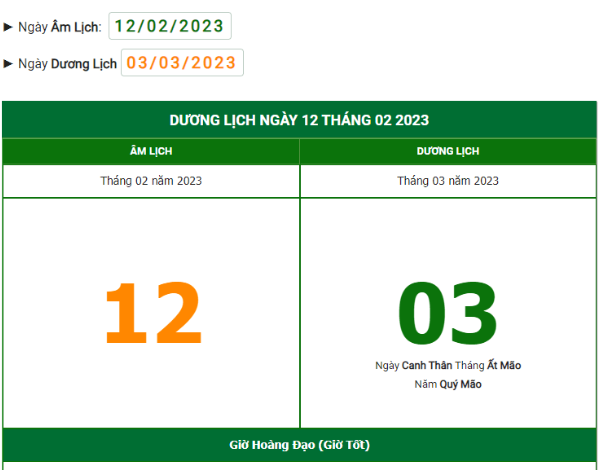What Happens When We Convert Doi Ngay Am Sang Ngay Duong?

When we convert doi ngay am sang ngay duong or change from lunar days to solar days it means we are switching from using the lunar calendar to the solar calendar. But what does that really mean? Well imagine you have two different types of calendars: one based on the moon and the other based on the sun. The lunar calendar follows the phases of the moon while the solar calendar follows the Earth’s orbit around the sun. When we convert we’re essentially figuring out how the dates on one calendar match up with the dates on the other.
Converting doi ngay am sang ngay duong helps us keep track of time in different ways. For example if we have a special event planned on a certain lunar date but we want to know what that date would be on the solar calendar we can use a conversion tool to find out. This way we can make sure we don’t miss any important dates and can celebrate them on the right day according to both calendars. It’s like having a map to navigate between two different worlds of timekeeping .
Exploring the Vietnamese Lunar Calendar
The Vietnamese lunar calendar is a fascinating way of marking time that has been used for centuries. Instead of being based on the sun like the solar calendar the lunar calendar follows the phases of the moon. This means that each month starts with the new moon and ends with the full moon. The Vietnamese people have used this calendar to plan their daily lives, festivals and agricultural activities for generations.
In the Vietnamese lunar calendar each day is associated with a specific animal from the zodiac such as the rat ox or dragon. These animals are believed to influence the characteristics of people born on those days. For example those born in the Year of the Dragon are said to be strong and ambitious while those born in the Year of the Rat are believed to be intelligent and resourceful. Understanding the Vietnamese lunar calendar helps us appreciate the rich cultural heritage of Vietnam and how its traditions are deeply connected to the natural world.
Discovering the Solar Calendar: What’s Different?
Unlike the lunar calendar which follows the moon’s phases, the solar calendar is based on the Earth’s orbit around the sun. This means that the solar calendar measures time based on the position of the sun in the sky. Instead of starting each month with a new moon like in the lunar calendar the solar calendar divides the year into 12 months with each month having a fixed number of days. This makes it easier to predict when certain events will occur such as the changing of seasons or the start of a new year.
One of the biggest differences between the lunar and solar calendars is how they handle leap years. In the solar calendar a leap year is added approximately every four years to keep the calendar year synchronized with the astronomical year. This extra day known as February 29th helps to make up for the fact that the Earth’s orbit around the sun is not exactly 365 days. However the lunar calendar does not have leap years in the same way as it is based solely on the moon’s phases.
Why Do We Use Both Lunar and Solar Calendars?
You might be wondering why we need to use both lunar and solar calendars? Well each calendar has its own unique advantages and cultural significance. The lunar calendar is often used to mark traditional festivals and religious holidays as it is deeply ingrained in cultural practices and beliefs. On the other hand the solar calendar is more commonly used for everyday purposes such as scheduling appointments, planning events and keeping track of time in a consistent manner.
By using both calendars we are able to honor both tradition and practicality. We can celebrate important cultural events according to the lunar calendar while also staying organized and efficient in our daily lives with the solar calendar. This dual approach allows us to maintain a connection to our cultural heritage while also adapting to the modern world.
Making Sense of Doi Ngay Am Sang Ngay Duong for Kids
Understanding the concept of doi ngay am sang ngay duong or converting lunar days to solar days might seem tricky at first but it’s actually quite simple . Think of the lunar calendar as a moon-based calendar and the solar calendar as a sun-based calendar. When we convert from one to the other we’re basically finding out how the dates match up between these two different ways of keeping track of time.
For kids it’s like solving a fun puzzle . Imagine you have two sets of blocks one with pictures of the moon and the other with pictures of the sun. By rearranging the blocks you can see how the moon and sun dates line up with each other. This helps us know when special days like birthdays or holidays are happening according to both calendars. So doi ngay am sang ngay duong is really just a cool way to make sure we don’t miss out on any important celebrations .
Fun Ways to Learn About Lunar and Solar Days
Learning about lunar and solar days can be an exciting adventure . There are so many fun activities you can do to explore these different ways of measuring time. For example you could create your own lunar calendar by drawing the phases of the moon each night and tracking how they change over the course of a month. Or you could make a solar clock using a sundial and watch how the shadow moves throughout the day as the sun travels across the sky.
Another fun idea is to celebrate special days from both calendars . You could have a lunar New Year party with traditional Vietnamese food and activities and then mark important solar calendar dates like the first day of spring or summer solstice with outdoor games and picnics. By combining learning with hands-on experiences and celebrations you’ll gain a deeper understanding of how doi ngay am sang ngay duong shapes our lives and cultures.
Let’s Convert: Practicing Doi Ngay Am Sang Ngay Duong
Ready to put your doi ngay am sang ngay duong skills to the test? Let’s practice converting lunar days to solar days and vice versa . Grab a calendar and choose a date from the lunar calendar. Then use a conversion tool or follow the steps to figure out what that date would be on the solar calendar. You can do this with friends or family members to make it even more fun .
Once you’ve mastered converting dates try applying your new knowledge to plan your own special events or celebrations. Maybe you want to host a lunar-themed party on the next full moon or mark important solar calendar dates like the first day of summer with a backyard barbecue. The possibilities are endless when you know how to doi ngay am sang ngay duong .
Celebrating Special Days in Both Lunar and Solar Calendars
In Vietnam we are fortunate to celebrate a rich tapestry of cultural traditions and holidays from both the lunar and solar calendars. From Tet Nguyen Tieu the lunar New Year to Tet Nguyen Dan the solar New Year each celebration brings its own unique customs, foods and festivities. By honoring special days from both calendars we not only connect with our heritage but also strengthen our bonds with family and community.
Whether it’s gathering with loved ones to enjoy traditional lunar dishes or rejoicing in the warmth of the sun during summer solstice celebrations every special day holds a special place in our hearts. By embracing the diversity of our calendars we create opportunities for joy, reflection and connection with the world around us. So let’s come together to celebrate doi ngay am sang ngay duong and all the magic it brings to our lives .
How Doi Ngay Am Sang Ngay Duong Shapes Our Daily Lives
Doi ngay am sang ngay duong the process of converting lunar days to solar days plays a significant role in shaping our daily lives. From planning important events to observing cultural traditions, understanding both lunar and solar calendars enriches our experiences and deepens our connections to the world around us.
For example knowing how to convert dates allows us to participate fully in cultural celebrations and rituals. Whether it’s the lunar New Year or a solar equinox, being able to mark these occasions on both calendars ensures that we don’t miss out on the joy and camaraderie that come with shared festivities. Additionally doi ngay am sang ngay duong helps us stay organized and punctual in our daily activities ensuring that we can effectively manage our schedules and meet our commitments.
Furthermore the practice of doi ngay am sang ngay duong fosters a sense of cultural pride and identity. By embracing the nuances of both lunar and solar calendars we honor the traditions passed down to us by our ancestors while also embracing the modern world. This integration of past and present tradition and innovation allows us to navigate the complexities of our multicultural society with confidence and grace. In essence doi ngay am sang ngay duong is not just about converting dates, it’s about embracing the richness of our cultural heritage and celebrating the diversity that makes us who we are.
Conclusion
Doi ngay am sang ngay duong serves as a bridge between two different ways of measuring time: the lunar calendar and the solar calendar. By understanding and practicing the conversion of dates between these two systems we gain valuable insights into our cultural traditions, strengthen our connections to the past and navigate the complexities of our modern world with ease. So let’s continue to embrace the beauty and diversity of doi ngay am sang ngay duong as we journey through life celebrating each day with gratitude and joy.



